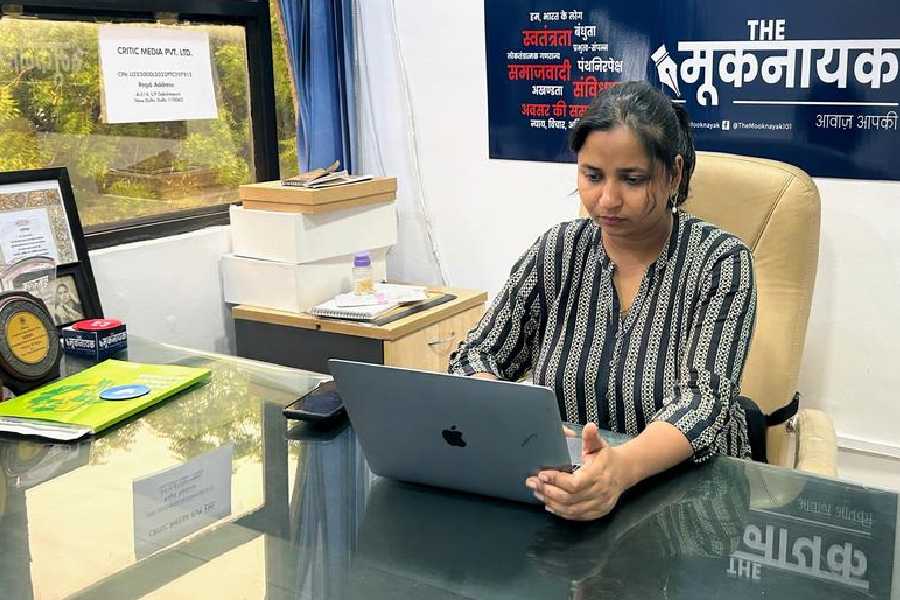Meena Kotwal comes from a family of manual laborers and grew up in a Dalit neighborhood in the Indian capital of New Delhi.
She became a journalist and worked for several mainstream media outlets. However, her experiences as a young journalist made her realize that a major part of Indian society was being overlooked.
"I realized the burden of my Dalit identity in mainstream Indian newsrooms where rampant caste blindness was normalized," she told DW.
"This gap pushed me to start my own media platform that would tell the stories from the [caste] margins of India," she said.
In 2019, Kotwal launched an online news platform called Mooknayak, which means "leader of the voiceless." Along with 14 journalists coming from diverse social groups in India, Kotwal aims to highlight stories of Dalits and other marginalized groups that go unreported in mainstream media.
The name for the platform was inspired by the architect of India's constitution B.R. Ambedkar. She runs her newsroom on the donations that she receives from crowdfunding. Recently, she secured funding from the Google News Initiative.
The news outlet publishes articles in both Hindi and English for wider reach. They shoot videos for their YouTube channel, aiming to cover stories that others do not, including atrocities and social injustices faced by Dalits.
Kotwal runs her news platform from Pushpa Bhawa, the same Dalit neighborhood in Delhi where she grew up.
India's caste-based newsrooms
The Hindu caste system dates back thousands of years and places around 300 million Dalits at the bottom of a social hierarchy.
The upper castes use the disparaging term "untouchables" to refer to Dalits. While the practice of untouchability in India has since been prohibited by the constitution, Dalits are still subjected to caste-based discrimination and violence.
A report released in October 2022 by Oxfam and the Indian digital news outlet, Newslaundry, revealed the glaring disproportionate representation of Dalits in Indian newsrooms.
According to the report, nearly 88% of journalists in India were from the general category or upper caste in 2019. Today, that percentage remains nearly unchanged.
Another Dalit journalist, Ashoka Das, founded the monthly magazine and news portal Dalit Dastak, which aims to spread awareness about Dalit society through news and mass media.
"The upper-caste gatekeeping is pervasive in Indian institutions, including, judiciary, and academia. Media is no exception here," Das told DW.
His experience as a Dalit journalist in upper-caste-dominated Indian newsrooms made Das realize how his identity created limitations.
"You don't rise above a certain rank. Your promotion is delayed. And this is clearly because of your caste identity," he said.
The challenges for Dalit media
In 2012, Das launched Dalit Dastak to provide a space for Dalit issues that were absent in mainstream media. Since then, the platform has risen in popularity, but faces lingering challenges like finding funding and maintaining a stable team.
Apart from these alternative Dalit media outlets, there is an emergence of other media initiatives, like Round Table India, and The Dalit Voice, which report extensively on Dalit issues with the purpose of raising awareness and consciousness among the citizens of India.
According to the Oxfam-Newslaundry report, of the 121 newsroom leadership positions examined, including editor-in-chief, managing editor, executive editor, bureau chief and input/output editor, 106 are held by upper-caste journalists.
Only five are held by other castes, and six by journalists from the minority communities. The identity of the remaining four individuals was unknown.
Harish Wankhede, a professor at the Jawaharlal Nehru University in New Delhi whose research focuses on caste in Indian media, said the coverage on Dalit issues by mainstream media is "disturbing."
"The rise of Dalit media as an alternative is very crucial and important to challenge the dominant narrative of the mainstream media that always buries the coverage of Dalit atrocities and Dalit perspectives in their stories," he told DW.
He added that Dalit media faces a considerable challenge in competing with well-funded competitors.
"To compete with mainstream media that is run by the upper caste businessmen, Dalit media is almost insignificant and has a long way to go."
Back in Pushpa Bhawan, Kotwa is busy at her desk thinking of how to arrange financing before the start of the next month. She hopes crowdfunding will come through. Her team is motivated and ready.










